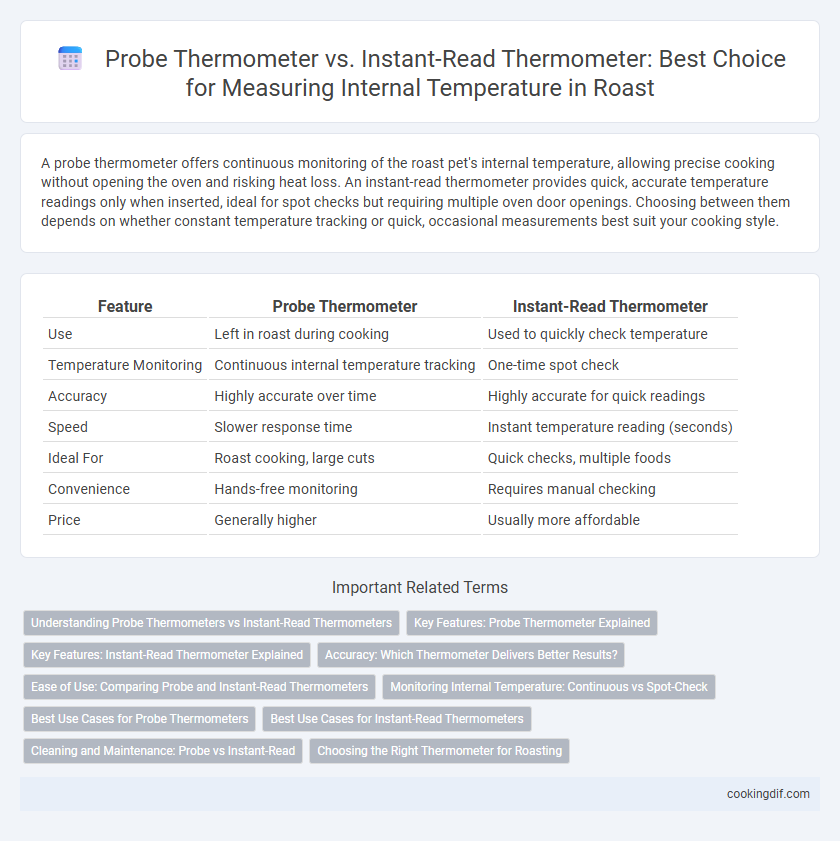A probe thermometer offers continuous monitoring of the roast pet's internal temperature, allowing precise cooking without opening the oven and risking heat loss. An instant-read thermometer provides quick, accurate temperature readings only when inserted, ideal for spot checks but requiring multiple oven door openings. Choosing between them depends on whether constant temperature tracking or quick, occasional measurements best suit your cooking style.
Table of Comparison
| Feature | Probe Thermometer | Instant-Read Thermometer |
|---|---|---|
| Use | Left in roast during cooking | Used to quickly check temperature |
| Temperature Monitoring | Continuous internal temperature tracking | One-time spot check |
| Accuracy | Highly accurate over time | Highly accurate for quick readings |
| Speed | Slower response time | Instant temperature reading (seconds) |
| Ideal For | Roast cooking, large cuts | Quick checks, multiple foods |
| Convenience | Hands-free monitoring | Requires manual checking |
| Price | Generally higher | Usually more affordable |
Understanding Probe Thermometers vs Instant-Read Thermometers
Probe thermometers offer continuous temperature monitoring by staying inserted in the roast throughout cooking, providing accurate internal temperature readings that help achieve precise doneness. Instant-read thermometers deliver quick, spot-check temperature measurements by briefly inserting into the meat, ideal for verifying final internal temperature before serving. Comparing both, probe thermometers are preferable for real-time monitoring, while instant-read thermometers excel in speedy temperature checks without prolonged heat exposure.
Key Features: Probe Thermometer Explained
A probe thermometer features a long, heat-resistant probe designed to remain in the roast throughout the cooking process, providing continuous and accurate internal temperature readings. Its built-in alarms and wireless capabilities allow for precise monitoring without opening the oven, preserving heat and ensuring consistency. This thermometer is ideal for slow-cooked meats and large roasts, delivering reliable data to perfect doneness levels.
Key Features: Instant-Read Thermometer Explained
An instant-read thermometer provides rapid temperature readings within 2-5 seconds, making it ideal for quickly checking the internal temp of a roast without prolonged heat exposure. Unlike probe thermometers, which stay inserted during cooking, instant-read devices require manual insertion, ensuring precise, spot-check measurements. Their compact design and digital display enhance convenience and accuracy, critical for achieving perfectly cooked roasts.
Accuracy: Which Thermometer Delivers Better Results?
Probe thermometers provide superior accuracy for measuring internal roast temperatures by maintaining constant contact with the meat, ensuring real-time, stable readings. Instant-read thermometers offer quick results but can vary due to temperature fluctuations and user technique, making them less reliable for precise accuracy. For consistent, accurate monitoring during roasting, probe thermometers deliver better temperature control and precise cooking results.
Ease of Use: Comparing Probe and Instant-Read Thermometers
Probe thermometers provide continuous monitoring by being inserted into the roast, allowing easy tracking of internal temperature without opening the oven. Instant-read thermometers require removing the roast to measure temperature, offering quick and accurate readings but less convenience during cooking. For ease of use, probe thermometers are ideal for hands-free, real-time temperature updates, while instant-read models excel in rapid temperature checks.
Monitoring Internal Temperature: Continuous vs Spot-Check
A probe thermometer enables continuous monitoring of a roast's internal temperature by remaining inserted during cooking, providing real-time data to prevent overcooking. An instant-read thermometer requires manual, spot-check measurements, offering quick temperature readings without disrupting the cooking process. Continuous tracking with a probe thermometer is ideal for precise temperature control, while instant-read thermometers are best for occasional verification.
Best Use Cases for Probe Thermometers
Probe thermometers are ideal for slow-cooked roasts because they stay inserted throughout the cooking process, providing continuous temperature monitoring without opening the oven. They offer precise internal temperature readings that help prevent overcooking and ensure perfect doneness. Best use cases include large cuts like prime rib, pork shoulder, and brisket where maintaining consistent heat is crucial.
Best Use Cases for Instant-Read Thermometers
Instant-read thermometers excel in providing rapid temperature readings, making them ideal for checking the internal temperature of roasts during critical cooking moments. Their quick response time helps prevent overcooking by allowing frequent temperature monitoring without prolonged oven exposure. This makes instant-read thermometers the best choice for precise doneness checks at various stages of roasting.
Cleaning and Maintenance: Probe vs Instant-Read
Probe thermometers require careful cleaning of the inserted metal probe after each use to prevent cross-contamination and ensure accurate readings, often necessitating a dishwasher-safe or wipeable cover for ease of maintenance. Instant-read thermometers, with their single unit design, are typically easier to clean quickly as they don't have detachable parts, although the sensor area must be handled with care to maintain precision. Both types benefit from regular calibration and proper storage to extend their lifespan and maintain hygiene standards during roast temperature monitoring.
Choosing the Right Thermometer for Roasting
Choosing the right thermometer for roasting hinges on accuracy and ease of use; probe thermometers provide continuous monitoring by staying inserted during cooking, ensuring precise internal temperature control. Instant-read thermometers deliver rapid, accurate readings but require frequent opening of the oven or meat for checks, potentially causing heat loss. For consistent roast results, a probe thermometer is ideal, while instant-read thermometers work best for quick final temperature verification.
Probe thermometer vs Instant-read thermometer for internal temp Infographic

 cookingdif.com
cookingdif.com